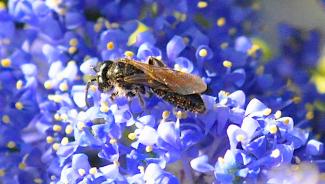
Image Credit: Sara Asher
Shiny black Panurgine Bees (Panurginus, Protandrena and Pseudopanurgus)
These bees have black bodies, are nearly hairless, and often have yellow markings on the faces of the males. Most of the species are restricted to the southwestern deserts. In the Pacific Northwest, the genus Panurginus is frequently encountered in natural meadows and backyards. Panurginus is the largest of these bees, but still quite tiny (usually less than one quarter of an inch; or about 4-6 mm). The Pacific Northwest species are specialists on members of the rose family (Spiraea, Rosa, cinquefoil (Potentilla), and ocean-spray (Holodiscus). In the Great Basin steppes, the genera Protandrena and Pseudopanurgus occur, but are seldom noticed due to their tiny size and black coloration (often with yellow marks on the legs, thorax and face). The former genus contains both specialists and generalists, while the latter has only summer aster-family specialists in our area.
The North American species in this group nest either solitarily or in gregarious groups. The nest cells are located very close to the surface of the ground, usually much less than 1 foot deep. I have personally observed literally thousands of bees nesting along a single row of shrub-cinquefoil in a nursery. There is a published record in Texas of a similar site being used for 20 consecutive years.


This Panurginus is characteristic of several North American genera, Panurginus are poorly studied, but many are suspected of being specialist pollinators. Unlike all the other genera in North America, Panurginus is shared with Eurasia. One favorite food source of several species of Panurginus is mountain-lilac (Ceanothus).